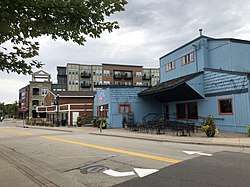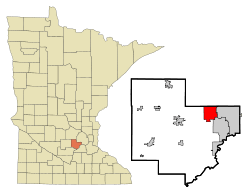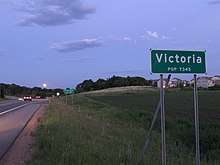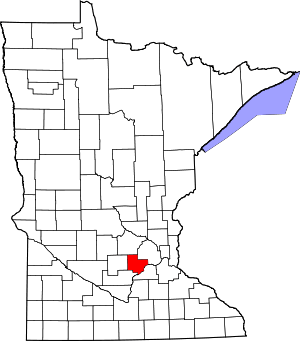Victoria, Minnesota
Victoria is a city in Carver County, Minnesota, United States. The population was 7,345 at the 2010 census.[6]
Victoria | |
|---|---|
 Downtown Victoria | |
 Location of the city of Victoria within Carver County, Minnesota | |
| Coordinates: 44°51′51″N 93°38′57″W | |
| Country | United States |
| State | Minnesota |
| County | Carver |
| Area | |
| • Total | 10.69 sq mi (27.70 km2) |
| • Land | 8.71 sq mi (22.57 km2) |
| • Water | 1.98 sq mi (5.13 km2) |
| Elevation | 988 ft (301 m) |
| Population | |
| • Total | 7,345 |
| • Estimate (2019)[3] | 10,206 |
| • Density | 1,171.35/sq mi (452.27/km2) |
| Time zone | UTC-6 (Central (CST)) |
| • Summer (DST) | UTC-5 (CDT) |
| ZIP code | 55386 |
| Area code(s) | 952 |
| FIPS code | 27-67036[4] |
| GNIS feature ID | 0653650[5] |
| Website | City of Victoria |
Geography

According to the United States Census Bureau, the city has a total area of 9.79 square miles (25.36 km2), of which, 8.01 square miles (20.75 km2) is land and 1.78 square miles (4.61 km2) is water.[7]
State Highways 5 and 7 are two of the main routes in Victoria.
Victoria has been nicknamed "The City of Lakes and Parks" because it has over 200 acres (0.81 km2) of reserved land, thirteen parks and nine lakes within its borders. Victoria is also home to the 1,800-acre (7.3 km2) Carver Park Reserve.
In the 1850s, Victoria's rich soil attracted many farmers from Germany, Switzerland, and the Netherlands.
History
Michael Diethelm is believed to be the first settler in Victoria after setting up a shelter for his wife and two children in 1851 near the present day St. Victoria Church. The city itself is named after the St. Victoria Church, built on 30 acres (120,000 m2) of land just north of Lake Bavaria in 1857. A year later, steamboats from St. Paul began bringing in additional supplies for early settlers. The settlement continued to grow from early farmers attracted by the city's rich soil. Eventually the steamboats to Chaska and the St. Paul railroad helped transform the local area into its own thriving community.[8]
Demographics
| Historical population | |||
|---|---|---|---|
| Census | Pop. | %± | |
| 1920 | 206 | — | |
| 1930 | 240 | 16.5% | |
| 1940 | 276 | 15.0% | |
| 1950 | 302 | 9.4% | |
| 1960 | 425 | 40.7% | |
| 1970 | 850 | 100.0% | |
| 1980 | 1,425 | 67.6% | |
| 1990 | 2,354 | 65.2% | |
| 2000 | 4,025 | 71.0% | |
| 2010 | 7,345 | 82.5% | |
| Est. 2019 | 10,206 | [3] | 39.0% |
| US Population at | |||
2010 census
As of the census[2] of 2010, there were 7,345 people, 2,435 households, and 2,055 families living in the city. The population density was 917.0 inhabitants per square mile (354.1/km2). There were 2,545 housing units at an average density of 317.7 per square mile (122.7/km2). The racial makeup of the city was 95.6% White, 0.5% African American, 0.1% Native American, 2.0% Asian, 0.3% from other races, and 1.5% from two or more races. Hispanic or Latino of any race were 2.0% of the population.
There were 2,435 households of which 49.4% had children under the age of 18 living with them, 76.7% were married couples living together, 5.4% had a female householder with no husband present, 2.3% had a male householder with no wife present, and 15.6% were non-families. 12.6% of all households were made up of individuals and 4.3% had someone living alone who was 65 years of age or older. The average household size was 2.99 and the average family size was 3.27.
The median age in the city was 38.9 years. 32.9% of residents were under the age of 18; 4.5% were between the ages of 18 and 24; 25.5% were from 25 to 44; 28.6% were from 45 to 64; and 8.5% were 65 years of age or older. The gender makeup of the city was 49.7% male and 50.3% female.
2000 census
As of the census[4] of 2000, there were 4,025 people, 1,367 households, and 1,141 families living in the city. The population density was 575.4 people per square mile (222.3/km2). There were 1,410 housing units at an average density of 201.6 per square mile (77.9/km2). The racial makeup of the city was 97.91% White, 0.27% African American, 0.12% Native American, 0.84% Asian, 0.37% from other races, and 0.47% from two or more races. Hispanic or Latino of any race were 0.99% of the population.
There were 1,367 households out of which 47.0% had children under the age of 18 living with them, 76.0% were married couples living together, 5.3% had a female householder with no husband present, and 16.5% were non-families. 11.3% of all households were made up of individuals and 3.4% had someone living alone who was 65 years of age or older. The average household size was 2.90 and the average family size was 3.17.
In the city, the population was spread out with 31.7% under the age of 18, 4.2% from 18 to 24, 33.5% from 25 to 44, 24.0% from 45 to 64, and 6.6% who were 65 years of age or older. The median age was 36 years. For every 100 females, there were 99.4 males. For every 100 females age 18 and over, there were 97.8 males.
The median income for a household in the city was $86,772, and the median income for a family was $91,681. Males had a median income of $60,931 versus $34,519 for females. The per capita income for the city was $38,929. About 1.3% of families and 2.3% of the population were below the poverty line, including 2.1% of those under age 18 and 2.2% of those age 65 or over.
Education
District 112 schools have an elementary school; Victoria Elementary, in 2005.
Chanhassen High School serves the majority of Victoria.[9]
Waconia Public Schools operates area public schools serving other parts of Victoria,[10] including Waconia High School.
The city is home to the co-ed college preparatory high school Holy Family Catholic High School.
References
| Wikimedia Commons has media related to Victoria, Minnesota. |
- "2019 U.S. Gazetteer Files". United States Census Bureau. Retrieved July 26, 2020.
- "U.S. Census website". United States Census Bureau. Retrieved 2012-11-13.
- "Population and Housing Unit Estimates". United States Census Bureau. May 24, 2020. Retrieved May 27, 2020.
- "U.S. Census website". United States Census Bureau. Retrieved 2008-01-31.
- "US Board on Geographic Names". United States Geological Survey. 2007-10-25. Retrieved 2008-01-31.
- "2010 Census Redistricting Data (Public Law 94-171) Summary File". American FactFinder. United States Census Bureau. Retrieved 27 April 2011.
- "US Gazetteer files 2010". United States Census Bureau. Archived from the original on 2011-02-20. Retrieved 2012-11-13.
- "City of Victoria, MN: History of Victoria". City of Victoria. Retrieved 2015. Check date values in:
|accessdate=(help) - "Chanhassen High School - School Boundaries Map (School Attendance Zone)". Minnesota HomeTownLocator. Retrieved 8 June 2020.
- "Why Waconia". Waconia Public Schools. Retrieved 2020-03-28.
